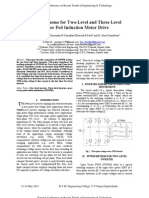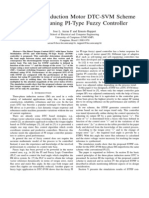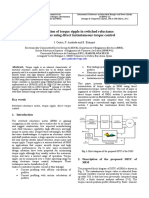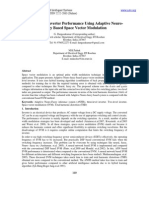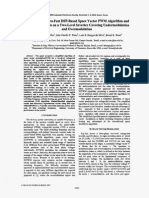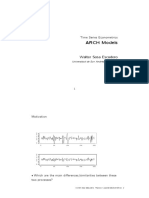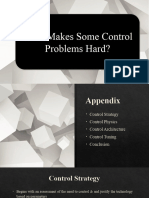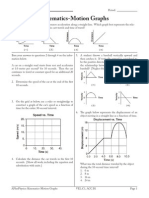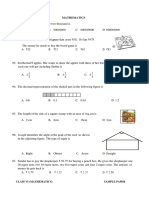Ds PIC
Ds PIC
Uploaded by
Sindhuja VijayaraghavanCopyright:
Available Formats
Ds PIC
Ds PIC
Uploaded by
Sindhuja VijayaraghavanOriginal Title
Copyright
Available Formats
Share this document
Did you find this document useful?
Is this content inappropriate?
Copyright:
Available Formats
Ds PIC
Ds PIC
Uploaded by
Sindhuja VijayaraghavanCopyright:
Available Formats
2010 International Journal of Computer Applications (0975 8887) Volume 1 No.
Real time MATLAB Interface for speed control of Induction motor drive using dsPIC 30F4011
R. Arulmozhiyal
Senior Lecturer, Sona College of Technology, Salem, TamilNadu, India.
K. Baskaran
N. Devarajan
J. Kanagaraj
Assistant Professor, PSG College of Technology, Coimbatore, TamilNadu, India.
Assistant Professor, Assistant Professor, Government College of Government College of Technology, Coimbatore, Technology, Coimbatore, TamilNadu, India TamilNadu, India.
ABSTRACT
This paper presents design and implementation of Real time MATLAB Interface for speed control of induction motor drive using dsPIC 30F4011. In recent years, the field oriented control of induction motor drive is widely used in high performance drive system .It is due to its unique characteristics like high efficiency, good power factor and extremely rugged .This scheme leads to be able to adjust the speed of the motor by control the frequency and amplitude of the stator voltage, the ratio of stator voltage to frequency should be kept constant
the dsPIC controller. Depends upon the controlled output, the controller produce the SVPWM signals, that signals feed back into the gate drive of the IGBT of Intelligent Power Module. Inverter output from the intelligent power module is given to the input of the induction motor.
Keywords
Fuzzy logic control (FLC), Membership Function, PIC digital signal microcontroller Induction motor, Intelligent Power Module.
1. INTRODUCTION
In recent years, speed control of induction motor drive is widely used in high performance drive system ,because of its advantages like high efficiency, very simple , extremely rugged, good power factor and it does not require starting motor. Induction motors are used in many applications such as HVAC, Industrial drives control, automotive control, etc... In recent years there has been a great demand in industry for adjustable speed drives [1]. Recently, Fuzzy logic control has found many applications in the past decade. Fuzzy Logic, deals with problems that have vagueness, uncertainty and use membership functions with values varying between 0 and 1[2]. This means that if the a reliable expert knowledge is not available or if the controlled system is too complex to derive the required decision rules, development of a fuzzy logic controller become time consuming and tedious or sometimes impossible. In the case that the expert knowledge is available, fine-tuning of the controller might be time consuming as well [3, 4]. Real time implementation of MATLAB Interface for speed control of induction motor drive using dsPIC 30F4011 as quite new. [5,6]. The aim of this paper is that it shows the dynamics response of speed with design the fuzzy logic controller to control a speed of Induction motor. This paper presents design and real time implementation of MATLAB Interface for speed control of induction motor drive using dsPIC 30F4011. Figure-1 Block diagram for the proposed system Figure-2 show the MATLAB work, where Query instrument is Digital signal PIC controller (dsPIC 30F 4011).The speed error e and the change of speed error ce are processed inputs through the fuzzy logic controller whose output is the controlled voltage to dsPIC controller. The controlled output voltage from the fuzzy logic controller is processed by PIC controller to produce a control frequency and Amplitude. This control frequency adjusts the V/f of SVPWM such that the desired speed of the motor can be obtained.
Figure-2 MATLAB work
2. Proposed speed control system:
Figure-1 shows the block diagram the proposed system. From the induction motor sense the speed using Quadature Encoder pulse (QEP) sensor , then Speed is given back to the Intelligent power Module(IPM) , From the IPM , speed converted into the voltage in analog form. Through the PIC controller analog form of the voltage converted in digital form. Digital form input to the MATLab Work. In the MATLab work we design the fuzzy logic control, from that we obtain the controlled output given to
3. FUZZY LOGIC CONTROL 3.1 FLC design
The process of fuzzy logic controller design includes the following steps. (i)Fuzzification: process of representing the inputs as suitable linguistic variable. (ii) decision Making: appropriate control action to carried out. It is based on the knowledge base and rule base. Knowledge base and rule base
85
2010 International Journal of Computer Applications (0975 8887) Volume 1 No. 5
are the details about the linguistic variables and control rules (iii) Defuzzification: Process of converting fuzzified output into crisp value. The inputs to the FLC are error (e) and change in error (ce). The output is the voltage of the switching signal. The universe of discourse of all the variables, covering the whole region, is expressed in per unit values. All the MFs are asymmetrical because near the origin, the signals require more precision. There are seven MFs for e and ce signal, whereas there are seven MFs for the output. All the MFs are symmetrical for positive and negative values of the variables. Table 1 shows the corresponding rule table for the speed controller. The top row and left column of the matrix indicate the fuzzy sets of the variables e and ce, respectively, and the MFs of the output variable du are shown in the body of the matrix. There may be 7*7 = 49 possible rules in the matrix. Mamdani type controller is chosen for this application and the basic rule of this type of controller is IF ce is PS AND e is NM THEN du is NS. Figure 3 (b). MF for change in speed error
Degree of MF
Degree of MF Voltage
Figure 3 (c). MF for voltage Table 2. Rule base Speed control ce/e NB NM NS Z PS NB NB NB NB NB NM NS Z NM NB NB NB NM NS Z PS NS NB NB NM NS Z PS PM Z NB NM NS Z PS PM PB PS NM NS Z PS PM PB PB PM NS Z PS PM PB PB PB PB Z PS PM PB PB PB PB
Speed Error
Figure 3 (a). MF for speed error
PM PB
Degree of MF
4. Space Vector Pulse Width Modulation :
The basic power circuit topology of a three-phase voltage source inverter supplying a star connected three-phase load is given in Figure 4. The power circuit contains in general six semiconductor switches such as MOSFETs, IGBTs, BJTs etc with antiparallel diodes for protection. The two power switch of one leg is complimentary in operation with a small dead band between the switching of two devices. Switching operation of the inverter yield in total 8 output vectors with 6 being active or non zero and two zero vectors. The six active vectors are labeled as V1, V2, V3, V4, V5,V6 and the two zero vectors are labeled as Vo and V7.
Change in speed error 86
2010 International Journal of Computer Applications (0975 8887) Volume 1 No. 5
P M S P M S P M W1 1 W3 3 W5
S 5 a
V d c
+ P M S P M S P M S W4 4 W6 6 W2 2
N b c
The second equation is termed as equal volt-sec. principle. 2The Figure 4 Power Circuit topology of a three-phase VSI. 1If these 8 voltage vectors are converted to 2 axis, it can be plotted as shown in Figure 5. The tips of the 6 non zero vectors, when cornered form a regular hexagon with the two zero vectors lying at the origin.
-a is x
k can assume only eight discrete inverter output voltage locations in the complex plane, including the zero voltage vectors. The zero voltage vector will be included in the switching sequence to minimize the commutations in the inverter (Turn ON and Turn OFF losses will be less). 3One can generate any voltage vector laying inside the hexagon whose corners on the six active switching state vectors (V 1 to V6) in space vector modulation strategy, the inverter out net
reference vector can be approximated during a sampling time t = 1/(2fs) by a sequence of 3 space voltage vectors Va, Vb and VN, where Va and Vb are 2 of the adjacent six active vector V1....V6 VN is a zero vector Vo and V7 chosen in such a way to minimize the commutations in the inverter fs is the switching frequency. The above time intervals Ta, Tb and To during which the switching state vectors Va, Vb and VN are applied are derived from the geometry of the hexagon and can be written as the following formulas
V( 1 ) 30 0
V( 1 ) 20 1
V ref
V b V( 1 ) 41 0
Vf r e V( 0 ) 10 1 V a -a is x
V( 1 ) 71 1 V( 0 ) 00 0 V( 0 ) 51 0 V( 0 ) 61 1
Figure - 5 Space voltage vectors of a three-phase VSI. The Vref in - plane rotates circularly, so that the output voltage will be sinusoidal. Since the voltage source inverter can have 8 states, Vref can only be synthesized by using 8 voltage vectors. There can be infinite ways to synthesize the input reference but the most simple is by using the two neighboring active vectors and a zero vector. In other words it can be said that the inverter is switched in such a way that the two neighboring output voltage is generated. If the direction of rotation of the reference vector is assumed as anticlockwise then the vector to the right is designated with suffix a and the vector lying on the left of the reference is denoted with suffix b. The inverter switching is done is such a way that one state (say 001) remains for some time (say Ta) and is followed by another state (say 011) for some time (say T b). The remaining time out of one switching period (Ts) is filled with the application of vector Vo for time T0/2 and vector V7 for time T0/2. Thus a symmetrical space vector modulation is obtained. If Vref is in 1st sector, then, where, Ta - Switching time for non zero vector (V1) in 1st sector Tb - Switching time for non zero vector (V2) in 1st sector T0 - Zero vector switching time (Vo ,V7) in 1st sector Ts - Total switching time period
4where is the angle between Va and , m is the modulation index. This is the generic solution for each sector in the plane, always varies in the interval (0-60). By varying the modulation index m and , the output voltage amplitude and frequency can be varied. Modulation index control the output voltage magnitude and controls the frequency of the output voltage. where, m Modulation index Vector Angle When equations for Ta, Tb & To are implemented in digital signal PIC micro controller, the compare registers value corresponding to Ta, Tb & To have to be calculated and loaded to generate the 6 PWMs for the three phase voltage source inverter. This results in 3 phase voltage output from a voltage inverter using space vector pulse width modulation. This SVPWM is used in vector control implementation when rotating reference frame operation is considered.
Vref
5. dsPIC MicroController:
The dsPIC30F is a High Performance Digital Signal Controllers with CPU module has a 16-bit (data) modified Harvard architecture with an enhanced Instruction set, including significant support for DSP. The instruction set includes many addressing modes and was designed for optimum C complier efficiency.
87
2010 International Journal of Computer Applications (0975 8887) Volume 1 No. 5
A. Features 1. High performance modified RISC CPU 2. 48 Kbytes on-chip Flash program space (16K Instruction words) 3. 2 Kb of on-chip data RAM and 1 Kb of nonvolatile data EEPROM 4. 4 MHz- 10 MHz oscillator input with PLL active (4x, 8x, 16 as) 5. 16 x 16- bit working register array 6. Timer module with programmable presale 7. 6-bit Capture input and 16- bit Compare/PWM output functions 8. 2 UART modules with FIFO Buffer 9. 6 PWM output channels 10. Analog-to-Digital Converter (A/D) with 4 S/H Inputs For more about features of aspic refer respective data sheet.
6. Pulse Generation Using dsPIC
A. Register Involved: I/O Port control registers: All I/O ports have three registers directly associated with the operation of the port, where x is a letter that denotes the particular I/O port. TRISx: Data Direction registers, PORTx: I/O Port registers, LATx: I/O Latch registers. Each I/O pin on the device has an associated bit in the TRIS, PORT and LAT Registers. Timers: TMRx: 16-bit timer count register, PRx: 16-bit period register associated with the timer, TxCON: 16-bit control register associated with the timer. Some16-bit timers can be combined to form a 32-bit timer. Input capture and output compare: The Input Capture module has multiple operating modes, which are selected via the ICxCON register. The dsPIC30F device may have up to eight output compare channels, designated OC1, OC2, OC3, etc., Each output compare channel can use one of two selectable time bases. The time base is selected using the OCTSEL bit (OCxCON<3>). Motor control PWM control registers: The control registers are PTOCN, PTMR, PTPER, PWMCON and PDC.
7. Hardware Results:
To evaluate the performance of the system, a series of measurements has been accomplished.
B. Flow chart:
Figure- 7 SVPWM By using the experimental setup we find the following results. Figure 7 show the Space Vector PWM. Figure. 8 (a, b) as shown speed response of the fuzzy logic controller with a fuzzy tuning rule based on Reference speed of 1000rpm and 1200 rpm.
88
2010 International Journal of Computer Applications (0975 8887) Volume 1 No. 5
Figure-8.a
Figure-9.b Figure.10 a as shown step down up speed response for 1400 to1000 RPM of the proposed system Figure.10 b as shown step down speed response for 1000 to500 RPM of the proposed system.
Figure-8.b Figure.9 a as shown step up speed response for 500 to1000 RPM of the proposed system. Figure.9 b as shown step up speed response for 1000 to1200 RPM of the proposed system.
Figure-10.a
Figure-9.a
Figure-10.b
8. Conclusion
This paper presents implementation of Real time MATLAB Interface for speed control of induction motor drive using dsPIC 30F4011. The experimental results are analyzed and, its found that the speed of the induction motor can be controlled in Normal, step up , step down response.
ACKNOWLEDGMENT
The authors wish to thank the Management, Principal and the Department of Electrical and Electronics Engineering, Sona
89
2010 International Journal of Computer Applications (0975 8887) Volume 1 No. 5
College of Technology, Salem-5, TamilNadu who have given facilities to do this research work successfully.
REFERENCE:
1) 2) 3) W. Leonhard, Control of Electrical Drives, Springer-Verlag Berlin Heidelberg, New York, Tokyo, 1985. Chuen Chien Lee, Fuzzy Logic in Control Systems: Fuzzy Logic controller Part1,2 1990 IEEE .. R.Arulmozhiyal and K.Baskaran,A Novel Approach to Induction motor speed control using FPGA,International Journal of Applied Engineering Research, ISSN 0973-4562, Volume 4, Number 1 (2009), pp 1-14. R.Arulmozhiyal and K.Baskaran, Space vector pulse width modulation based speed control of Induction motor using Fuzzy PI controller, International Journal of Computer and Electrical Engineering, ISSN 1793-8198, Volume 1, Number 1 (2009), pp 98-103. High Performance Digital Signal Controllers dspic30f Family Reference Manual and data sheet www.microchip.com
4)
5) 6)
90
You might also like
- C683 TemplateDocument2 pagesC683 Templatel lNo ratings yet
- Implementation of A Fuzzy PI Controller For Speed Control of Induction Motors Using FPGADocument7 pagesImplementation of A Fuzzy PI Controller For Speed Control of Induction Motors Using FPGABharati RajaNo ratings yet
- Direct Torque Control For Induction Motor Using Intelligent Artificial Neural Network TechniqueDocument7 pagesDirect Torque Control For Induction Motor Using Intelligent Artificial Neural Network TechniqueInternational Journal of Application or Innovation in Engineering & ManagementNo ratings yet
- Inverter and SV-PWMDocument5 pagesInverter and SV-PWMcoep05No ratings yet
- Comparision Between Two Level and Three Level Inverter For Direct Torque Control Induction Motor DriveDocument8 pagesComparision Between Two Level and Three Level Inverter For Direct Torque Control Induction Motor DriveMatanAbutbulNo ratings yet
- A Vector Controlled Induction Motor Drive With Neural Network Based Space Vector Pulse Width ModulatorDocument8 pagesA Vector Controlled Induction Motor Drive With Neural Network Based Space Vector Pulse Width ModulatorTiruchengode VinothNo ratings yet
- Design and Implementation of Space Vector PWM Inverter Based On A Low Cost MicrocontrollerDocument12 pagesDesign and Implementation of Space Vector PWM Inverter Based On A Low Cost MicrocontrollerHaider NeamaNo ratings yet
- Space Vector Pulse Width Modulation Schemes For Two-Level Voltage Source InverterDocument5 pagesSpace Vector Pulse Width Modulation Schemes For Two-Level Voltage Source InverterIDESNo ratings yet
- Simulation of A Space Vector PWM Controller For A Five-Level Voltage-Fed Inverter Motor DriveDocument7 pagesSimulation of A Space Vector PWM Controller For A Five-Level Voltage-Fed Inverter Motor DriveIOSRjournalNo ratings yet
- A Simple Direct-Torque Neuro-Fuzzy Control of PWM-Inverter-Fed Induction Motor DriveDocument8 pagesA Simple Direct-Torque Neuro-Fuzzy Control of PWM-Inverter-Fed Induction Motor DrivegsmaniprabaNo ratings yet
- Direct Torque Control of Induction Motor Using Artificial Neural NetworkDocument7 pagesDirect Torque Control of Induction Motor Using Artificial Neural NetworkMohamed SomaiNo ratings yet
- Hysteresis ControllerDocument9 pagesHysteresis ControllerengrarNo ratings yet
- SVPWM Scheme For Two-Level and Three Level Inverter Fed Induction Motor DriveDocument6 pagesSVPWM Scheme For Two-Level and Three Level Inverter Fed Induction Motor DriveEzra NaveenaNo ratings yet
- Three-Phase Induction Motor DTC-SVM Scheme With Self-Tuning PI-Type Fuzzy ControllerDocument6 pagesThree-Phase Induction Motor DTC-SVM Scheme With Self-Tuning PI-Type Fuzzy Controllerjorgeluis.unknownman667No ratings yet
- A New Approach Based On Sinusoidal PWM Inverter With PI Controller For Vector Control of Induction MotorDocument7 pagesA New Approach Based On Sinusoidal PWM Inverter With PI Controller For Vector Control of Induction MotortheijesNo ratings yet
- Paper 5Document11 pagesPaper 5Rama KrishnaNo ratings yet
- Vector Control of A Permanent-Magnet Synchronous Motor Using AC-AC Matrix ConverterDocument11 pagesVector Control of A Permanent-Magnet Synchronous Motor Using AC-AC Matrix ConverterKushagra KhamesraNo ratings yet
- Implementation of Induction Motor Drive Control Schemes in MATLAB/Simulink/dSPACE Environment For Educational PurposeDocument23 pagesImplementation of Induction Motor Drive Control Schemes in MATLAB/Simulink/dSPACE Environment For Educational PurposeMos CraciunNo ratings yet
- Research PaperDocument10 pagesResearch PaperVikas PatelNo ratings yet
- Application of Space Vector Modulation in Direct Torque Control of PMSMDocument4 pagesApplication of Space Vector Modulation in Direct Torque Control of PMSMenmnabilNo ratings yet
- JESV5SI0109Document5 pagesJESV5SI0109Kiran YaddanapudiNo ratings yet
- DTC SVMDocument22 pagesDTC SVMxeta123No ratings yet
- Simplified SVPWM-DTC of 3-Phase Induction Motor Using The Concept of Imaginary Switching TimesDocument6 pagesSimplified SVPWM-DTC of 3-Phase Induction Motor Using The Concept of Imaginary Switching Timesdjoo77No ratings yet
- Comparison of SPWM and SVPWM Scheme For Two-Level Inverter Fed Induction Motor DriveDocument6 pagesComparison of SPWM and SVPWM Scheme For Two-Level Inverter Fed Induction Motor Drivemanish_er570No ratings yet
- Modeling and Simulation of The DC Motor Using Matlab and LabviewDocument6 pagesModeling and Simulation of The DC Motor Using Matlab and LabviewnghiepmechanNo ratings yet
- Basic SVPWMDocument6 pagesBasic SVPWMVAMSIKRISHNAEEENo ratings yet
- Design and Customization of Embedded Based Direct Torque Controller OfInduction MotorDocument6 pagesDesign and Customization of Embedded Based Direct Torque Controller OfInduction MotorTJPRC PublicationsNo ratings yet
- Implementation of Direct TorqueDocument7 pagesImplementation of Direct TorquevalentinmullerNo ratings yet
- Vector Control of AC Motor Drive For Active Damping of Output Using Passive Filter ResonanceDocument6 pagesVector Control of AC Motor Drive For Active Damping of Output Using Passive Filter ResonanceijaertNo ratings yet
- A Novel Current Controlled Space Vector Modulation Based Control Scheme For Reducing Torque Ripple in Brushless DC DrivesDocument7 pagesA Novel Current Controlled Space Vector Modulation Based Control Scheme For Reducing Torque Ripple in Brushless DC DrivesKoukou AmkoukouNo ratings yet
- Minimization of Torque Ripple in Switched Reluctance Motor Drives Using Direct Instantaneous Torque ControlDocument5 pagesMinimization of Torque Ripple in Switched Reluctance Motor Drives Using Direct Instantaneous Torque ControlAnel Bey TahirbegoviçNo ratings yet
- A Three-to-Five-Phase Matrix Converter BasedFive - Phase Induction Motor Drive SystemDocument5 pagesA Three-to-Five-Phase Matrix Converter BasedFive - Phase Induction Motor Drive SystemidescitationNo ratings yet
- Im 8Document7 pagesIm 8maheswaranNo ratings yet
- DC Link Approach To Variable-Speed, Sensorless,: Induction Motor DriveDocument5 pagesDC Link Approach To Variable-Speed, Sensorless,: Induction Motor DrivesamirmansourNo ratings yet
- Low Cost Digital Signal Generation For Driving Space Vector PWM InverterDocument12 pagesLow Cost Digital Signal Generation For Driving Space Vector PWM InverterJunaid AhmadNo ratings yet
- Ga Speed and DQ Currnets Control of PMSM WithDocument9 pagesGa Speed and DQ Currnets Control of PMSM Withhieuhuech1No ratings yet
- 3 Phase Ac Servomotor Switching SystemDocument7 pages3 Phase Ac Servomotor Switching SystemLaboratorio Recife FlateckNo ratings yet
- FPGA Implementation On SVPWM MLIDocument5 pagesFPGA Implementation On SVPWM MLISheetal VermaNo ratings yet
- Three-Level Inverter Performance Using Adaptive Neuro-Fuzzy Based Space Vector ModulationDocument14 pagesThree-Level Inverter Performance Using Adaptive Neuro-Fuzzy Based Space Vector ModulationiisteNo ratings yet
- New Direct Torque Control Scheme of Induction Motor For Electric VehiclesDocument7 pagesNew Direct Torque Control Scheme of Induction Motor For Electric VehiclesPrasanth RamavarapuNo ratings yet
- 2012-MS0EE095 - PaperDocument5 pages2012-MS0EE095 - PaperTalha MehmoodNo ratings yet
- High Performance Direct Torque Control of Induction Motor Drives Using Space Vector ModulationDocument9 pagesHigh Performance Direct Torque Control of Induction Motor Drives Using Space Vector ModulationMefisto ElNo ratings yet
- Discontinuous PWM Techniques For Open-End Winding Induction Motor Drive For Zero Sequence Voltage EliminationDocument13 pagesDiscontinuous PWM Techniques For Open-End Winding Induction Motor Drive For Zero Sequence Voltage EliminationarunkmepesNo ratings yet
- Complex Controller For Three-Phase Induction Motor Direct Torque Control PDFDocument7 pagesComplex Controller For Three-Phase Induction Motor Direct Torque Control PDFccprado1No ratings yet
- Space-Vector Modulation in A Two-Phase Induction Motor Drive For Constant-Power OperationDocument8 pagesSpace-Vector Modulation in A Two-Phase Induction Motor Drive For Constant-Power OperationinfodotzNo ratings yet
- Modified Space Vector Pulse Width Modulation For Z-Source InvertersDocument3 pagesModified Space Vector Pulse Width Modulation For Z-Source InvertersRamana ReddyNo ratings yet
- ANN Switched Z-Source Inverter Based PV Generation System: AbstractDocument9 pagesANN Switched Z-Source Inverter Based PV Generation System: AbstractsathishNo ratings yet
- Simulation by Composite ModelDocument8 pagesSimulation by Composite Modelanshgarg786No ratings yet
- InvertersDocument7 pagesInverterslohitashriyaNo ratings yet
- 245915-FinalDocument13 pages245915-FinalUtkarsh PrakashNo ratings yet
- Direct Torque Control of Induction MotorsDocument6 pagesDirect Torque Control of Induction MotorsInternational Journal of Application or Innovation in Engineering & ManagementNo ratings yet
- A Simple and Ultra-Fast DSP-Based Space Vector PWM Algorithm andDocument6 pagesA Simple and Ultra-Fast DSP-Based Space Vector PWM Algorithm andShiviAroraNo ratings yet
- A Variable-Speed, Sensorless, Induction Motor Drive Using DC Link MeasurementsDocument6 pagesA Variable-Speed, Sensorless, Induction Motor Drive Using DC Link Measurementsgowtam_raviNo ratings yet
- Mathematical Modelling Boost ConverterDocument12 pagesMathematical Modelling Boost ConverterCHERU ABINETNo ratings yet
- Ijrte0205288291 PDFDocument4 pagesIjrte0205288291 PDFPasupuleti SivakumarNo ratings yet
- Simulation of Some Power System, Control System and Power Electronics Case Studies Using Matlab and PowerWorld SimulatorFrom EverandSimulation of Some Power System, Control System and Power Electronics Case Studies Using Matlab and PowerWorld SimulatorNo ratings yet
- Simulation of Some Power Electronics Case Studies in Matlab Simpowersystem BlocksetFrom EverandSimulation of Some Power Electronics Case Studies in Matlab Simpowersystem BlocksetNo ratings yet
- Simulation of Some Power Electronics Case Studies in Matlab Simpowersystem BlocksetFrom EverandSimulation of Some Power Electronics Case Studies in Matlab Simpowersystem BlocksetNo ratings yet
- Some Power Electronics Case Studies Using Matlab Simpowersystem BlocksetFrom EverandSome Power Electronics Case Studies Using Matlab Simpowersystem BlocksetNo ratings yet
- Analog Dialogue, Volume 48, Number 1: Analog Dialogue, #13From EverandAnalog Dialogue, Volume 48, Number 1: Analog Dialogue, #13Rating: 4 out of 5 stars4/5 (1)
- 15.3 Open Coiled Helical Springs: To and MeanDocument19 pages15.3 Open Coiled Helical Springs: To and MeanBiswadeep Roy ChoudhuryNo ratings yet
- Psudeo With Explainations2Document33 pagesPsudeo With Explainations2IMTEYAZ mallick100% (1)
- ARCH Models: Time Series EconometricsDocument9 pagesARCH Models: Time Series EconometricsPierre Chavez AlcoserNo ratings yet
- Application of Knapsack AlgorithmDocument5 pagesApplication of Knapsack Algorithmramrajan75% (4)
- Newunit 4Document52 pagesNewunit 4Dinesh RajNo ratings yet
- QB KEE101T ElectricalDocument15 pagesQB KEE101T Electricalplantforest16No ratings yet
- Full Length Test-1Document22 pagesFull Length Test-1soumyaranjan dashNo ratings yet
- Calculus For Bus and Econ Sample PDFDocument5 pagesCalculus For Bus and Econ Sample PDFWade GrayNo ratings yet
- Introduction To Matlab Application To Electrical Engineering Part IDocument99 pagesIntroduction To Matlab Application To Electrical Engineering Part ITrương ĐứcNo ratings yet
- What Makes Some Control Problems Hard?Document13 pagesWhat Makes Some Control Problems Hard?Sakshi TiwariNo ratings yet
- Algebra II Test 2Document5 pagesAlgebra II Test 2feleciafoyNo ratings yet
- Analyzing Cost-Volume-Profit IssuesDocument55 pagesAnalyzing Cost-Volume-Profit IssuesVaisal AmirNo ratings yet
- UNT Lesson Plan TemplateDocument3 pagesUNT Lesson Plan Templateapi-273347960No ratings yet
- 13 Fourier Series (Zill)Document13 pages13 Fourier Series (Zill)Rara salsabila simanjuntakNo ratings yet
- Power System Operation and Control: Session 3Document28 pagesPower System Operation and Control: Session 3wise manNo ratings yet
- 3.kinematics Motion GraphsDocument3 pages3.kinematics Motion GraphsBryan Cedric Narne0% (1)
- Maths CBSE-12-CHAPTER-6-WORKSHEETSDocument7 pagesMaths CBSE-12-CHAPTER-6-WORKSHEETSshaunak krithishNo ratings yet
- Vedic Mathematics: Corrolaries To Base MultiplicationDocument5 pagesVedic Mathematics: Corrolaries To Base MultiplicationVinod ShankarNo ratings yet
- Mathematics: Class Vi (Mathematics) Sample PaperDocument2 pagesMathematics: Class Vi (Mathematics) Sample PaperSARVODAYA GROUPNo ratings yet
- StatDocument2 pagesStatMurali VNo ratings yet
- Springerbriefs in Computer Science: Series EditorsDocument9 pagesSpringerbriefs in Computer Science: Series EditorsLinkin EvilNo ratings yet
- Samson 373X 5Document8 pagesSamson 373X 5Arun KumarNo ratings yet
- SJCJC NewDocument41 pagesSJCJC NewChristian MirandaNo ratings yet
- Assignment Bca DBMSDocument13 pagesAssignment Bca DBMSbinalamitNo ratings yet
- Gouw 2014Document23 pagesGouw 2014Lissa ChooNo ratings yet
- Math 7 Maya (Fourth)Document2 pagesMath 7 Maya (Fourth)Rolly BaquerNo ratings yet
- F3 First Term Revision Set 2 2023Document12 pagesF3 First Term Revision Set 2 2023TAN LAU GUAN HONG MoeNo ratings yet













